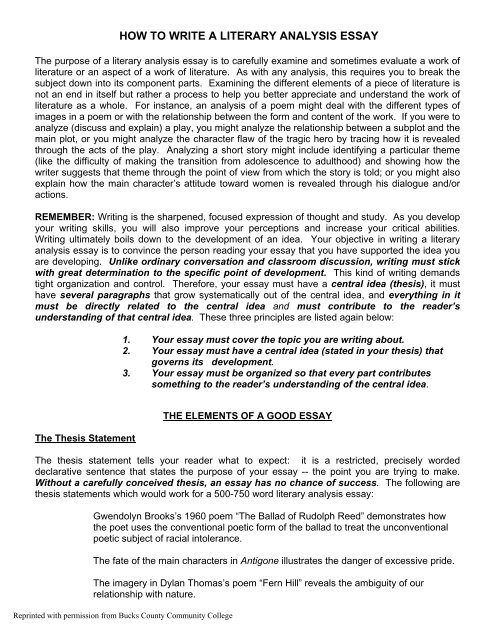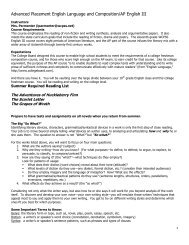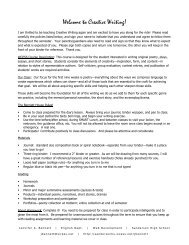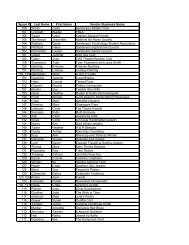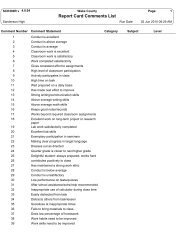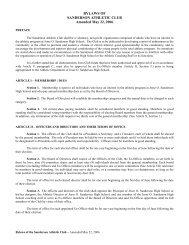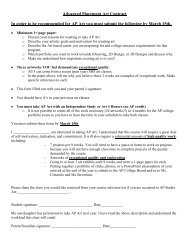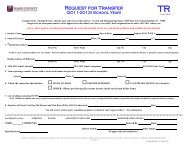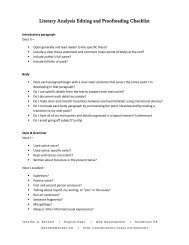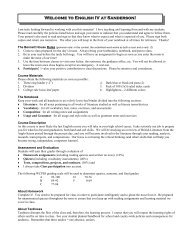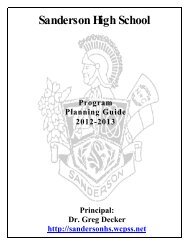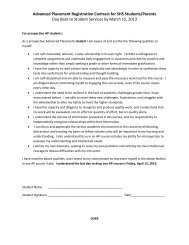HOW TO WRITE A LITERARY ANALYSIS ESSAY
HOW TO WRITE A LITERARY ANALYSIS ESSAY
HOW TO WRITE A LITERARY ANALYSIS ESSAY
Create successful ePaper yourself
Turn your PDF publications into a flip-book with our unique Google optimized e-Paper software.
Reprinted with permission from Bucks County Community College3Each of the paragraphs of your essay should contain a topic sentence (usually the first sentenceof the paragraph) which states one of the topics associated with your thesis, combined with someassertion about how the topic will support the central idea. The purpose of the topic sentence istwofold:1. To tie the details of the paragraph to your thesis statement.2. To tie the details of the paragraph together.The substance of each of your developmental paragraphs (the body of your essay) will be theexplanations, summaries, paraphrases, specific details, and direct quotations you need to supportand develop the more general statement you have made in your topic sentence. The following isthe first developmental paragraph after one of the introductory paragraphs (C) above:<strong>TO</strong>PIC SENTENCEEXPLANATIONS ANDTEXTUAL EVIDENCESammy's descriptions of the A & P present asetting that is ugly, monotonous, and rigidlyregulated. We can identify with the uniformitySammy describes because we have all been inchain stores. The fluorescent light is as blandlycool as the "checkerboard green-and-creamrubber tile floor" (486). The "usual traffic in thestore moves in one direction (except for theswim suited girls, who move against it), andeverything is neatly organized and categorizedin tidy aisles. The dehumanizing routine of thisenvironment is suggested by Sammy's offhandreferences to the typical shoppers as "sheep,""house slaves," and "pigs." These regularcustomers seem to walk through the store in astupor; as Sammy tells us, not even dynamitecould move them out of their routine (485).This paragraph is a strong one because it is developed through the use of quotations, summary,details, and explanation to support the topic sentence. Notice how it relates back to the thesisstatement.The ConclusionYour literary analysis essay should have a concluding paragraph that gives your essay a sense ofcompleteness and lets your readers know that they have come to the end of your paper. Yourconcluding paragraph might restate the thesis in different words, summarize the main points youhave made, or make a relevant comment about the literary work you are analyzing, but from adifferent perspective. Do not introduce a new topic in your conclusion. Below is theconcluding paragraph from the essay already quoted above (A) about Browning's poem "My LastDuchess":If the Duke has any redeeming qualities, they fail to appear in the poem. Browning'semphasis on the Duke's traits of arrogance, jealousy, and materialism make it apparent thatanyone who might have known the Duke personally would have based his opinion of him onthese three personality "flaws." Ultimately, our opinion of the Duke is not a favorable one,and it is clear that Browning meant us to feel this way.
5example (also from the paper on "The Secret Lion") of how to "translate" original material into partof your own paper:Original:"I was twelve and in junior high school and something happened that we didn'thave a name for, but it was nonetheless like a lion, and roaring, roaring thatway the biggest things do."Paraphrase: Early in the story, the narrator tells us that when he turned twelve and startedjunior high school, life changed in a significant way that he and his friendscouldn't quite find a name for.Specific DetailVarious types of details from the text lend concrete support to the development of the central ideaof your literary analysis essay. These details add credibility to the point you are developing.Below is a list of some of the details which could have been used in the developmental paragraphfrom the paper on John Updike's short story "A & P" (see the paragraph again for which detailswere used and how they were used).Using Direct QuotationsReprinted with permission from Bucks County Community College"usual traffic""fluorescent lights""checkerboard green-and-cream rubber-tile floor""electric eye"shoppers like "sheep," "houseslaves," and "pigs"neatly stacked fooddynamiteQuotations can illuminate and support the ideas you are trying to develop. A judicious use ofquoted material will make your points clearer and more convincing. As with all the textualevidence you use, make sure you explain how the evidence is relevant -- let the reader knowwhat you make of the quotations you cite. Below are guidelines and examples that should helpyou use quotations effectively:1. Brief quotations (four lines or fewer of prose and three lines or fewer of poetry) should becarefully introduced and integrated into the text of your paper. Put quotation marks aroundall briefly quoted material.Prose example:As the "manager" of the A & P, Lengel is both the guardian and enforcer of "policy." Whenhe gives the girls "that sad Sunday-school-superintendent stare," we know we are in thepresence of the A & P's version of a dreary bureaucrat who "doesn't miss much" (487).Make sure you give page numbers when necessary. Notice that in this example thepage numbers are in parenthesis after the quotation marks but before the period.Poetry example:From the beginning, the Duke in Browning's poem gives the reader a sense of howpossessive he really is: "That's my last Duchess on the wall, / Looking as if she were alive"
6(1-2). We can't help notice how, even though the Duke is talking about her portrait, his mainconcern is that she belongs to him. Notice that line # 1 is separated from line # 2 by aslash. Make sure you give the line numbers when necessary.2. Lengthy quotations should be separated from the text of your paper. More than four linesof prose should be double spaced and indented ten spaces from the left margin, with theright margin the same as the rest of your paper. More than three lines of poetry should bedouble spaced and centered on the page. Note: do not use quotation marks to set offthese longer passages because the indentation itself indicates that the material isquoted.Prose example:The first paragraph of "The Secret Lion" introduces the narrator as someone who has justentered adolescence and isn't quite sure what to make of it:I was twelve and in junior high school and something happened that we didn't have aname for, but it was there nonetheless like a lion, and roaring, roaring that way thebiggest things do. Everything changed. Just that. Like the rug, the one that getspulled -- or better, like the tablecloth those magicians pull where the stuff on the tablestays the same but the gasp! from the audience makes the staying-the-same part notmatter. Like that. (41-42) Make sure you give page numbers when necessary.Notice in this example that the page numbers are in parenthesis after theperiod of the last sentence.Poetry example:The Duke seems to object to the fact that his "last Duchess" is not discriminating enoughabout bestowing her affection. In the following lines from the middle of the poem, the Dukelists examples of this "fault":Sir, 'twas all one! My favor at her breast,The drooping of the daylight in the west,The bough of cherries some officious foolBroke in the orchard for her, the white muleShe rode with round the terrace -- all and eachWould draw from her alike the approving speech. (25-30)Make sure you give line numbers when necessary.3. If any words are added to a quotation in order to explain who or what the quotation refers to,you must use brackets to distinguish your addition from the original source.Example:The literary critic John Strauss asserts that "he [Young Goodman Brown] is portrayed asself-righteous and disillusioned." Brackets are used here because there is no way ofknowing who "he" is unless you add that information.Reprinted with permission from Bucks County Community College
7Brackets are also used to change the grammatical structure of a quotation so that it fits intoyour sentence.Example:Strauss also argues that Hawthorne "present[s] Young Goodman Brown in an ambivalentlight." Brackets are used here to add the "s" to the verb "present" because otherwisethe sentence would not be grammatically correct.4. You must use ellipsis if you omit any words from the original source you are quoting.Ellipsis can be used at the beginning, in the middle, or at the end of the quotation,depending on where the missing words were originally. Ellipsis is formed by either threeor four periods with a space between each period.Original: "Early to bed and early to rise makes a man healthy, wealthy and wise."Example (omission from beginning):This behavior ". . . makes a man healthy, wealthy, and wise." Ellipsis formed by threedots after the quotation marks.Example (omission from middle):This maxim claims that "Early to bed . . . makes a man healthy, wealthy, and wise." Ellipsisformed by three dots used in place of the words "and early to rise."Example (omission from end):He said, "Early to bed and early to rise makes a man healthy . . . ." Ellipsis is formed byfour dots before the quotation marks -- the fourth dot is really a period which endsthe sentence.5. Use a single line of spaced periods to indicate the omission of an entire line of poetry.Example:The Duke seems to object to the fact that his "last Duchess" is not discriminating enoughabout bestowing her affection:. . . . . . . . . . . . . . . . . . . . . . . . . . . . . . . . .The drooping of the daylight in the West,The bough of cherries some officious foolBroke in the orchard for her, while the white muleShe rode around the terrace -- like and eachWould draw from her alike the approving speech. (26-30)Punctuating Direct QuotationsYou will be able to punctuate quoted materials accurately if you observe the following conventionsReprinted with permission from Bucks County Community College
B, and C above).92. Use the correct format for referring to the work you are discussing. The titles of shortstories, poems, and essays should be placed in quotation marks; the titles of novels, plays,films, and TV shows should be either underlined or italicized:"My Last Duchess" (poem) Antigone (play)"The Secret Lion" (short story) Forest Gump (movie)Pride and Prejudice (novel) Roseanne (TV show)3. Use the present tense when you are discussing and writing about literature -- literary worksare considered to exist in the present (see all the example paragraphs throughout).CHECKLIST1. Is the topic you have chosen to write about manageable for the length of the paper you arewriting?Is it too narrow or too broad?2. Is your title engaging? Does it suggest the approach you are taking in your paper?3. Does your first paragraph introduce your topic, name the writer and the work, and end withyour thesis statement? Will it get the reader's attention?4. Is your thesis clear? Does it state the central idea of your paper?5. Is your paper organized in a way that your reader will be able to follow?6. Are your developmental paragraphs unified (everything in the paragraph relates to the topicof the paragraph) and coherent (everything in the paragraph is arranged in a logical order)?7. Have you used transitional words where necessary within each paragraph? Are theretransitions linking all the paragraphs of your essay?8. Does your concluding paragraph provide a sense of closure?9. Have you used technical terms correctly?10. Have you used brief summary, paraphrase, specific details, and direct quotations? Haveyou explained why you are using them and how they support your central idea?11. If you have used information from sources outside the actual work of literature (for example,books of criticism), have you documented this information properly? To providedocumentation for literary papers, you need to use MLA documentation style, which canfound in most English handbooks and in books on how to write research papers.12. Have you proofread your final draft?Reprinted with permission from Bucks County Community College


